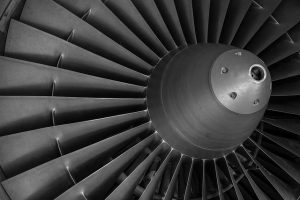 Jet engines are a common component of most commercial airplanes. They are designed to generate thrust by burning fuel and oxygen within a sealed chamber, known as a combustion chamber. As a jet engine releases exhaust gases, it propels the airplane forward. Below are five facts about jet engines and how they work.
Jet engines are a common component of most commercial airplanes. They are designed to generate thrust by burning fuel and oxygen within a sealed chamber, known as a combustion chamber. As a jet engine releases exhaust gases, it propels the airplane forward. Below are five facts about jet engines and how they work.
#1) 30,000 Horsepower
It’s not uncommon for jet engines to produce over 30,000 horsepower. To put that number into perspective, most cars and trucks use engines with between 100 and 200 horsepower. Airplanes, of course, require stronger and more powerful engines because of their weight. They weigh more than cars and trucks. To create a sufficient amount of propulsion, high-horsepower engines are required.
#2) Patented in the Early 1900s
The first patent for a jet engine was filed in the early 1900s by Maxine Guillaume. In his patent, Guillaume proposed an axial-flow turbojet engine for use in airplanes. Guillaume never constructed this jet engine, but his patent would provide the framework for other jet engines to emerge.
#3) Expensive
It shouldn’t come as a surprise to learn that jet engines are expensive. While costs vary, most jet engines have a price tag of around $10 million to $40 million each. And being that most commercial airplanes use multiple engines, the cost of production can be quite expensive. Aerospace manufacturing companies must use multiple jet engines in each commercial airplane, resulting in a high cost for the commercial airplanes to which they sell them.
#4) Multiple Types
Not all jet engines are the same. There are multiple types of jet engines, each of which works in a different way. Some airplanes use airbreathing jet engines. They are very efficient and provide a decent amount of thrust. Other airplanes use gas turbine engines. Gas turbine engines are a type of rotary engine that generate propulsion via combustion. Perhaps the most common type of jet engine is turbojet. Turbojet engines are designed to compress air, which they mix with fuel to generate combustion. Turbojet engines burn this mixture of fuel and compressed air to generate thrust that propels the respective airplane through the air.
#5) Thrust-to-Weight Ratio
All jet engines have a thrust-to-weight ratio. As the name suggests, it’s a measurement of a jet engine’s thrust relative to its weight. Heavier jet engines require more thrust. If a jet engine fails to produce a sufficient amount of thrust, it may not struggle to keep the airplane up in the air. Jet engines can have a thrust-to-weight ratio of 1.8 to over 100.



